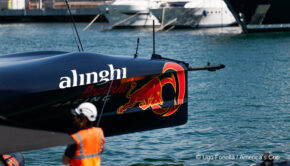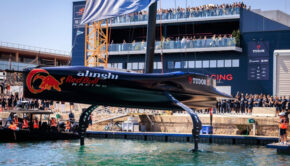The Future of the America’s Cup
Published on June 27th, 2017
Continuity is historically a struggle with the America’s Cup, but it had been more so under the reign of Oracle Team USA. Their legal pursuit after the 2007 edition put the event in cooler, and their regular changes to boats, formats, and venues for the 2013 and 2017 contests were disruptive.
The future of the event is now in the hands of the new winner, Emirates Team New Zealand, and the Italian challenger Luna Rossa. Certainly, a lot of what was on display in Bermuda, and in the lead up events, had been embraced by sailors and spectators, but has it all been good for the America’s Cup?
What is it that has made the America’s Cup the oldest trophy in international sport, and the most prized accomplishment in sailing? Stephen A Van Dyck shares his thoughts.
I was intimately involved in the America’s Cup from 1971 until 1980. My greatest moments in sailing were winning it three times. I love the Cup, and I would love to see it perpetuated in the spirit that propelled it to be sailing’s greatest event. It was also sailing’s highest level of achievement for many years.
I believe my views are important as the future of the Cup is being debated in New Zealand. I hasten to point out that this is the second America’s Cup that I have rooted against my own country, the USA. Or more to the point, I have rooted against Oracle. What a sad day indeed when loyalties to the individual competitor crews has taken precedent over national loyalties.
1. From its inception, the Cup was supposed to be friendly competition between nations. If a nation is not first and foremost its people, then what is it? How is it possible that in the final race, no real American is on the American boat? How is it possible that a large majority of Cup event sailors are all from New Zealand or Australia? How is this a competition between nations?
This may now be the only chance to reinsert a meaningful nationality clause into the event. With New Zealand’s win in Bermuda, they obviously have an advantage in their defense if there were a more meaningful nationality clause. I will not debate the merits of what the onboard requirement should be, but it should not be as hollow as it is now. By the way, the greatest competition between nations, the Olympics, requires national competitors.
2. Let’s get back to having the stewards of the Cup keep the tradition and sailing objectives foremost. At some point in recent history–I will not argue when–the major event decisions were taken over by, or in the interest of, professional sailors. It was often quoted, “We will not have a good event if we cannot keep the sailors fully employed.” Is that the mission of the event?
Worse, many of the practical elements of the event have been decided by professional sailors. Look at the big dollar contracts that some of the professionals involved are getting. Where do their incentives lie? I rather suspect their primary interest is making sure the Cup can make money, Formula 1 style.
I am not opposed to sailors being paid, I am opposed to professional sailors essentially running the event, for their own interests. Yes the pro sailors are in favor of big TV audiences, that’s where the money is. Think F1. Is that best for the Cup?
3. It is time for a sailboat again in the America’s Cup. I agree that watching New Zealand do a face plant at 30 knots was exciting and brought more interest to the event. True, we never did that on the 12’s (I am not suggest going back to the lead mines), but are we really trying to appeal to the crash-and-burn audience? Is there not enough crash and burn in life already? TV producers love it, advertisers love it, but the America’s Cup?
For those who argue the foiling boats are sailboats, please note the key metric for the TV audience is FLYING TIME. Flying on the foils. Foils below and wings above. And a jib to make it look like a sailboat. What?
These boats fly close hauled upwind and down. One can’t tell which legs the boats are on by looking at the angle of sail. This may be some kind of sailing, but how does this connect to the average sailor? What technology on these boats really relates to the average sailor? Does the technology coming out of this to make sailing more fun, safe, cost efficient and appealing to sailors?
Say what you want about F1, but look at the technology transfer to every day cars. Hybrid drive, fuel efficiency, radial tires, super brakes, carbon structures, and safety elements galore. And F1 drivers do just what I do. Hit the gas, steer and hit the brakes. They do not fly their cars. There are few items on my Porsche race car that are not on my Porsche street car, and I drive it just same way, just a lot slower.
Congratulations to the whole New Zealand team on an amazing challenge. What a beautiful performance. I sure hope they can take these points to heart as they choose how to defend the world’s oldest sporting trophy.









 We’ll keep your information safe.
We’ll keep your information safe.